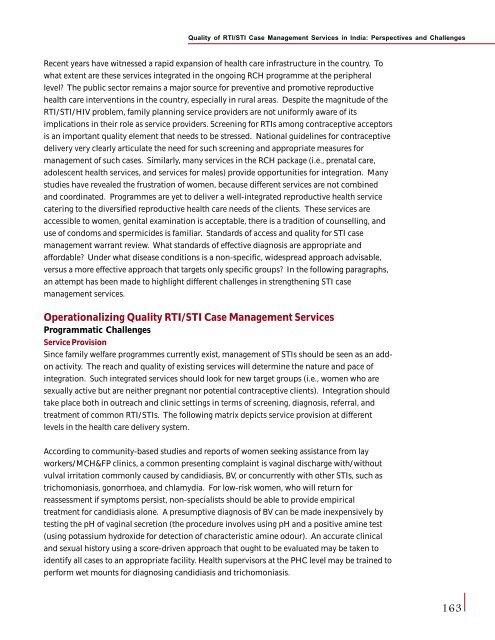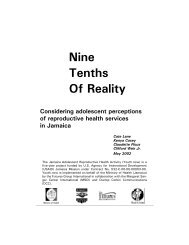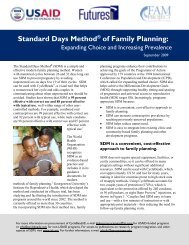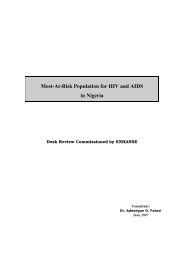Health Policy Issues and Health Programmes in ... - Amazon S3
Health Policy Issues and Health Programmes in ... - Amazon S3
Health Policy Issues and Health Programmes in ... - Amazon S3
- No tags were found...
You also want an ePaper? Increase the reach of your titles
YUMPU automatically turns print PDFs into web optimized ePapers that Google loves.
Quality of RTI/STI Case Management Services <strong>in</strong> India: Perspectives <strong>and</strong> ChallengesRecent years have witnessed a rapid expansion of health care <strong>in</strong>frastructure <strong>in</strong> the country. Towhat extent are these services <strong>in</strong>tegrated <strong>in</strong> the ongo<strong>in</strong>g RCH programme at the peripherallevel? The public sector rema<strong>in</strong>s a major source for preventive <strong>and</strong> promotive reproductivehealth care <strong>in</strong>terventions <strong>in</strong> the country, especially <strong>in</strong> rural areas. Despite the magnitude of theRTI/STI/HIV problem, family plann<strong>in</strong>g service providers are not uniformly aware of itsimplications <strong>in</strong> their role as service providers. Screen<strong>in</strong>g for RTIs among contraceptive acceptorsis an important quality element that needs to be stressed. National guidel<strong>in</strong>es for contraceptivedelivery very clearly articulate the need for such screen<strong>in</strong>g <strong>and</strong> appropriate measures formanagement of such cases. Similarly, many services <strong>in</strong> the RCH package (i.e., prenatal care,adolescent health services, <strong>and</strong> services for males) provide opportunities for <strong>in</strong>tegration. Manystudies have revealed the frustration of women, because different services are not comb<strong>in</strong>ed<strong>and</strong> coord<strong>in</strong>ated. <strong>Programmes</strong> are yet to deliver a well-<strong>in</strong>tegrated reproductive health servicecater<strong>in</strong>g to the diversified reproductive health care needs of the clients. These services areaccessible to women, genital exam<strong>in</strong>ation is acceptable, there is a tradition of counsell<strong>in</strong>g, <strong>and</strong>use of condoms <strong>and</strong> spermicides is familiar. St<strong>and</strong>ards of access <strong>and</strong> quality for STI casemanagement warrant review. What st<strong>and</strong>ards of effective diagnosis are appropriate <strong>and</strong>affordable? Under what disease conditions is a non-specific, widespread approach advisable,versus a more effective approach that targets only specific groups? In the follow<strong>in</strong>g paragraphs,an attempt has been made to highlight different challenges <strong>in</strong> strengthen<strong>in</strong>g STI casemanagement services.Operationaliz<strong>in</strong>g Quality RTI/STI Case Management ServicesProgrammatic ChallengesService ProvisionS<strong>in</strong>ce family welfare programmes currently exist, management of STIs should be seen as an addonactivity. The reach <strong>and</strong> quality of exist<strong>in</strong>g services will determ<strong>in</strong>e the nature <strong>and</strong> pace of<strong>in</strong>tegration. Such <strong>in</strong>tegrated services should look for new target groups (i.e., women who aresexually active but are neither pregnant nor potential contraceptive clients). Integration shouldtake place both <strong>in</strong> outreach <strong>and</strong> cl<strong>in</strong>ic sett<strong>in</strong>gs <strong>in</strong> terms of screen<strong>in</strong>g, diagnosis, referral, <strong>and</strong>treatment of common RTI/STIs. The follow<strong>in</strong>g matrix depicts service provision at differentlevels <strong>in</strong> the health care delivery system.Accord<strong>in</strong>g to community-based studies <strong>and</strong> reports of women seek<strong>in</strong>g assistance from layworkers/MCH&FP cl<strong>in</strong>ics, a common present<strong>in</strong>g compla<strong>in</strong>t is vag<strong>in</strong>al discharge with/withoutvulval irritation commonly caused by c<strong>and</strong>idiasis, BV, or concurrently with other STIs, such astrichomoniasis, gonorrhoea, <strong>and</strong> chlamydia. For low-risk women, who will return forreassessment if symptoms persist, non-specialists should be able to provide empiricaltreatment for c<strong>and</strong>idiasis alone. A presumptive diagnosis of BV can be made <strong>in</strong>expensively bytest<strong>in</strong>g the pH of vag<strong>in</strong>al secretion (the procedure <strong>in</strong>volves us<strong>in</strong>g pH <strong>and</strong> a positive am<strong>in</strong>e test(us<strong>in</strong>g potassium hydroxide for detection of characteristic am<strong>in</strong>e odour). An accurate cl<strong>in</strong>ical<strong>and</strong> sexual history us<strong>in</strong>g a score-driven approach that ought to be evaluated may be taken toidentify all cases to an appropriate facility. <strong>Health</strong> supervisors at the PHC level may be tra<strong>in</strong>ed toperform wet mounts for diagnos<strong>in</strong>g c<strong>and</strong>idiasis <strong>and</strong> trichomoniasis.163







